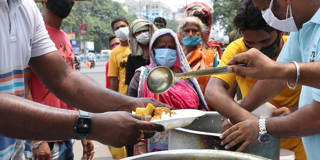 Debajyoti Chakraborty/NurPhoto via Getty Images
Debajyoti Chakraborty/NurPhoto via Getty Images
政府如何触达最落后群体
纽约—实施可持续发展目标(SDG,从 2015 年到 2030 年)的时限已经过半,但距离实现这些目标并没有到半途。 事实上,在许多关键领域——从贫困到粮食安全——近年来由于严重和复杂的危机,进展出现倒退。 在这种困难的环境中,世界各国政府必须紧急重新承诺实现SDG,包括不让任何人掉队的基本承诺。
挑战是艰巨的。 以SDG 1为例,它旨在消除一切形式的贫困。 根据世界银行的经济包容合作伙伴关系,政府主导的扶贫计划在 2021 年激增。但为了帮助最落后群体,这些计划必须识别并考虑将人们事实“困在”贫困中的互相交叠的网络。
正如全球多维贫困指数所强调的,贫困包括营养、卫生、医疗保健和教育等多个领域的剥夺和排斥。 性别、残疾和流离失所等因素是让人们陷入贫困的重要原因。 最近基于孟加拉国农村经验的研究表明,低于某个收入/资产门槛,家庭获得可增加收入的资源的能力将受到严重限制。 研究还表明,为穷人创造更好就业机会的大量资源转移和/或支持是长期摆脱贫困陷阱的有效手段。
https://prosyn.org/xiGutoHzh
To continue reading, register now. It’s free!
Register Now
Already have an account?
Log in



纽约—实施可持续发展目标(SDG,从 2015 年到 2030 年)的时限已经过半,但距离实现这些目标并没有到半途。 事实上,在许多关键领域——从贫困到粮食安全——近年来由于严重和复杂的危机,进展出现倒退。 在这种困难的环境中,世界各国政府必须紧急重新承诺实现SDG,包括不让任何人掉队的基本承诺。
挑战是艰巨的。 以SDG 1为例,它旨在消除一切形式的贫困。 根据世界银行的经济包容合作伙伴关系,政府主导的扶贫计划在 2021 年激增。但为了帮助最落后群体,这些计划必须识别并考虑将人们事实“困在”贫困中的互相交叠的网络。
正如全球多维贫困指数所强调的,贫困包括营养、卫生、医疗保健和教育等多个领域的剥夺和排斥。 性别、残疾和流离失所等因素是让人们陷入贫困的重要原因。 最近基于孟加拉国农村经验的研究表明,低于某个收入/资产门槛,家庭获得可增加收入的资源的能力将受到严重限制。 研究还表明,为穷人创造更好就业机会的大量资源转移和/或支持是长期摆脱贫困陷阱的有效手段。